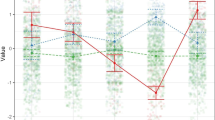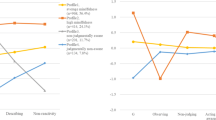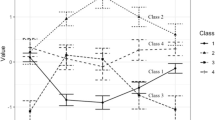Abstract
Objectives
Person-centered analytic approaches (e.g., latent profile analysis, cluster analysis) have been offered as a potential solution to measurement issues associated with the Five Facet Mindfulness Questionnaire (FFMQ). Yet, extant literature utilizing person-centered approaches reveals a lack of consistency in the identified mindfulness profiles, especially in non-college samples. The present study tested the generalizability of FFMQ profiles in an adult life span, community sample using latent profile analysis and cluster analysis. Furthermore, the study explored whether mindfulness profiles related to age and well-being.
Methods
Age-diverse participants (N = 715) recruited through Amazon’s Mechanical Turk completed the FFMQ and numerous measures of well-being.
Results
Cluster analysis revealed four mindfulness profiles: (1) high mindfulness, (2) low mindfulness, (3) judgmentally observing, and (4) nonjudgmentally aware. Latent profile analysis indicated four profiles, but only two profiles resembled profiles resulting from the cluster analysis, and two of the profiles comprised less than 9% of the sample combined. Using profiles identified by cluster analysis, older age was associated with increased likelihood of classification into a high mindfulness profile and decreased likelihood of classification into a low mindfulness profile. Furthermore, the high mindfulness profile showed the best well-being and the low mindfulness profile showed the worst.
Conclusions
Overall, these findings demonstrate that the type of analytic method and sample characteristics, such as age, may affect the makeup of resulting mindfulness profiles. Implications for the state of this literature are discussed.


Similar content being viewed by others
References
Akaike, H. (1974). A new look at the statistical model identification. Automatic Control, IEEE Transactions on, 19, 716–723. https://doi.org/10.1109/TAC.1974.1100705.
Aldenderfer, M. S., & Blashfield, R. K. (1984). Cluster analysis: quantitative applications in the social sciences. Beverly Hills: Sage Publication.
Andersen, S. M. (1990). The inevitability of future suffering: the role of depressive predictive certainty in depression. Social Cognition, 8, 203–228. https://doi.org/10.1521/soco.1990.8.2.203.
Baer, R. A., Smith, G. T., & Allen, K. B. (2004). Assessment of mindfulness by self-report: the Kentucky inventory of mindfulness skills. Assessment, 11, 191–206. https://doi.org/10.1177/1073191104268029.
Baer, R. A., Smith, G. T., Hopkins, J., Krietemeyer, J., & Toney, L. (2006). Using self-report assessment methods to explore facets of mindfulness. Assessment, 13, 27–45. https://doi.org/10.1177/1073191105283504.
Baer, R. A., Smith, G. T., Lykins, E., Button, D., Krietemeyer, J., Sauer, S., Walsh, E., Duggan, D., & Williams, J. M. G. (2008). Construct validity of the five facet mindfulness questionnaire in meditating and nonmeditating samples. Assessment, 15, 329–342. https://doi.org/10.1177/1073191107313003.
Barnhofer, T., Duggan, D. S., & Griffith, J. W. (2011). Dispositional mindfulness moderates the relation between neuroticism and depressive symptoms. Personality and Individual Differences, 51, 958–962. https://doi.org/10.1016/j.paid.2011.07.032.
Bergman, L. R., & Magnusson, D. (1997). A person-oriented approach in research on developmental psychopathology. Development and Psychopathology, 9, 291–319.
Bergomi, C., Tschacher, W., & Kupper, Z. (2013). The assessment of mindfulness with self-report measures: existing scales and open issues. Mindfulness, 4, 191–202.
Bishop, S. R., Lau, M., Shapiro, S., Carlson, L., Anderson, N. D., Carmody, J., et al. (2004). Mindfulness: a proposed operational definition. Clinical Psychology: Science and Practice, 11, 230–241.
Bravo, A. J., Boothe, L. G., & Pearson, M. R. (2016). Getting personal with mindfulness: a latent profile analysis of mindfulness and psychological outcomes. Mindfulness, 7, 420–432. https://doi.org/10.1007/s12671-015-0459-7.
Bravo, A. J., Pearson, M. R., & Kelley, M. L. (2018). Mindfulness and psychological health outcomes: a latent profile analysis among military personnel and college students. Mindfulness, 9, 258–270.
Brown, K. W., & Ryan, R. M. (2003). The benefits of being present: mindfulness and its role in psychological well-being. Journal of Personality and Social Psychology, 84, 822–848. https://doi.org/10.1037/0022-3514.84.4.822.
Brown, K. W., Ryan, R. M., & Creswell, D. J. (2007). Mindfulness: theoretical foundations and evidence for salutary effects. Psychological Inquiry, 18, 211–237. https://doi.org/10.1080/10478400701598298.
Brown, D. B., Bravo, A. J., Roos, C. R., & Pearson, M. R. (2015). Five facets of mindfulness and psychological health: evaluating a psychological model of the mechanisms of mindfulness. Mindfulness, 6, 1021–1032. https://doi.org/10.1007/s12671-014-0349-4.
Buchheld, N., Grossman, P., & Walach, H. (2001). Measuring mindfulness in insight meditation (Vipassana) and meditation based psychotherapy: the development of the Freiburg Mindfulness Inventory (FMI). Journal for Meditation and Meditation Research, 1, 11–34.
Buhrmester, M., Kwang, T., & Gosling, S. D. (2011). Amazon’s Mechanical Turk: a new source of inexpensive, yet high-quality, data? Perspectives on Psychological Science, 6, 3–5.
Carmody, J., & Baer, R. A. (2008). Relationships between mindfulness practice and levels of mindfulness, medical and psychological symptoms and well-being in a mindfulness-based stress reduction program. Journal of Behavioral Medicine, 31, 23–33. https://doi.org/10.1007/s10865-007-9130-7.
Carstensen, L. L. (2006). The influence of a sense of time on human development. Science, 312(5782), 1913–1915.
Carstensen, L. L., Isaacowitz, D. M., & Charles, S. T. (1999). Taking time seriously: a theory of socioemotional selectivity. American Psychologist, 54, 165–181.
Chadwick, P., Hember, M., Mead, S., Lilley, B., & Dagnan, D. (2005). Responding mindfully to unpleasant thoughts and images: reliability and validity of the Mindfulness Questionnaire. Unpublished manuscript.
Charles, S. T., & Carstensen, L. L. (2010). Social and emotional aging. Annual Review of Psychology, 61, 383–409.
Clark, S.L., Muthén, B. (2009). Relating latent class analysis results to variables not included in the analysis. Available from http://www.statmodel.com/download/relatinglca.pd.
Clatworthy, J., Hankins, M., Buick, D., Weinman, J., & Horne, R. (2007). Cluster analysis in illness perception research: a Monte Carlo study to identify the most appropriate method. Psychology and Health, 22, 123–142.
Coffey, K. A., Hartman, M., & Fredrickson, B. L. (2010). Deconstructing mindfulness and constructing mental health: understanding mindfulness and its mechanisms of action. Mindfulness, 1, 235–253. https://doi.org/10.1007/s12671-010-0033-2.
Davidson, R. J., & Kaszniak, A. W. (2015). Conceptual and methodological issues in research on mindfulness and meditation. American Psychologist, 70, 581–592.
Desrosiers, A., Vine, V., Klemanski, D. H., & Nolen-Hoeksema, S. (2013). Mindfulness and emotion regulation in depression and anxiety: common and distinct mechanisms of action. Depression and Anxiety, 30, 654–661. https://doi.org/10.1002/da.22124.
Diener, E. D., Emmons, R. A., Larsen, R. J., & Griffin, S. (1985). The satisfaction with life scale. Journal of Personality Assessment, 49, 71–75. https://doi.org/10.1207/s15327752jpa4901_13.
DiStefano, C., & Kamphaus, R. W. (2006). Investigating subtypes of child development: a comparison of cluster analysis and latent class cluster analysis in typology creation. Educational and Psychological Measurement, 66, 778–794.
Feldman, G., Hayes, A., Kumar, S., Greeson, J., & Laurenceau, J. P. (2007). Mindfulness and emotion regulation: the development and initial validation of the Cognitive and Affective Mindfulness Scale-Revised (CAMS-R). Journal of Psychopathology and Behavioral Assessment, 29, 177–190.
Fernandez, A. C., Wood, M. D., Stein, L. A. R., & Rossi, J. S. (2010). Measuring mindfulness and examining its relationship with alcohol use and negative consequences. Psychology of Addictive Behaviors, 24, 608–616. https://doi.org/10.1037/a0021742.
Ford, C. G., & Shook, N. J. (2019). Negative cognitive Bias and perceived stress: independent mediators of the relation between mindfulness and emotional distress. Mindfulness, 10, 100–110.
Frank, D. J., Nara, B., Zavagnin, M., Touron, D. R., & Kane, M. J. (2015). Validating older adults’ reports of less mind-wandering: an examination of eye movements and dispositional influences. Psychology and Aging, 30, 266–278. https://doi.org/10.1037/pag0000031.
Grossman, P. (2011). Defining mindfulness by how poorly I think I pay attention during everyday awareness and other intractable problems for psychology’s (re)invention of mindfulness: comment on Brown et al. Psychological Assessment., 23, 1034–1040.
Gu, J., Karl, A., Baer, R., Strauss, C., Barnhofer, T., & Crane, C. (2020). Latent profile analysis of the five facet mindfulness questionnaire in a sample with a history of recurrent depression. Assessment, 27(1), 149–163.
He, W., Goodkind, D., & Kowal, P. (2015). An aging world: 2015 (pp. 1–160). International Population Reports: U.S. Census Bureau.
Henry, D. B., Tolan, P. H., & Gorman-Smith, D. (2005). Cluster analysis in family psychology research. Journal of Family Psychology, 19, 121–132. https://doi.org/10.1037/0893-3200.19.1.121.
Henson, J. M., Reise, S. P., & Kim, K. H. (2007). Detecting mixtures from structural model differences using latent variable mixture modeling: a comparison of relative model fit statistics. Structural equation modeling: a multidisciplinary journal, 14, 202–226.
Hofmann, S. G., Sawyer, A. T., Witt, A. A., & Oh, D. (2010). The effect of mindfulness-based therapy on anxiety and depression: a meta-analytic review. Journal of Consulting and Clinical Psychology, 78, 169–183. https://doi.org/10.1037/a0018555.
Hohaus, L. C., & Spark, J. (2013). Getting better with age: do mindfulness & psychological well-being improve in old age? European Psychiatry, 28, 1. https://doi.org/10.1016/S0924-9338(13)77295-X.
Kabat-Zinn, J. (1994). Wherever you go, there you are: mindfulness meditation in everyday life. New York: Hyperion.
Khoury, B., Lecomte, T., Fortin, G., Masse, M., Therien, P., Bouchard, V., et al. (2013). Mindfulness-based therapy: a comprehensive meta-analysis. Clinical Psychology Review, 33, 763–771.
Kiken, L. G., & Shook, N. J. (2012). Mindfulness and emotional distress: the role of negatively biased cognition. Personality and Individual Differences, 52, 329–333. https://doi.org/10.1016/j.paid.2011.10.031.
Kimmes, J. G., Durtschi, J. A., & Fincham, F. D. (2017). Perception in romantic relationships: a latent profile analysis of trait mindfulness in relation to attachment and attributions. Mindfulness, 8, 1328–1338.
Lam, K. F., Lim, H. A., Kua, E. H., Griva, K., & Mahendran, R. (2018). Mindfulness and cancer patients’ emotional states: a latent profile analysis among newly diagnosed cancer patients. Mindfulness, 9, 521–533.
Lilja, J. L., Lundh, L. G., Josefsson, T., & Falkenström, F. (2013). Observing as an essential facet of mindfulness: a comparison of FFMQ patterns in meditating and non-meditating individuals. Mindfulness, 4, 203–212. https://doi.org/10.1007/s12671-012-0111-8.
Lo, Y., Mendell, N. R., & Rubin, D. B. (2001). Testing the number of components in a normal mixture. Biometrika, 88, 767–778.
Lyubomirsky, S., & Lepper, H. S. (1999). A measure of subjective happiness: preliminary reliability and construct validation. Social Indicators Research, 46, 137–155. https://doi.org/10.1023/A:1006824100041.
Mahoney, C. T., Segal, D. L., & Coolidge, F. L. (2015). Anxiety sensitivity, experiential avoidance, and mindfulness among younger and older adults: age differences in risk factors for anxiety symptoms. The International Journal of Aging and Human Development, 81, 217–240. https://doi.org/10.1177/0091415015621309.
Morey, L. C., Blashfield, R. K., & Skinner, H. A. (1983). A comparison of cluster analysis techniques withing a sequential validation framework. Multivariate Behavioral Research, 18, 309–329.
Mroczek, D. K., & Kolarz, C. M. (1998). The effect of age on positive and negative affect: a developmental perspective on happiness. Journal of Personality and Social Ppsychology, 75, 1333–1349. https://doi.org/10.1037/0022-3514.75.5.1333.
Muthén, L. K., & Muthén, B. O. (1998–2012). Mplus user’s guide (Seventh ed.). Los Angeles: Muthén & Muthén.
Pearson, M. R., Lawless, A. K., Brown, D. B., & Bravo, A. J. (2015). Mindfulness and emotional outcomes: identifying subgroups of college students using latent profile analysis. Personality and Individual Differences, 76, 33–38. https://doi.org/10.1016/j.paid.2014.11.009.
Podsakoff, P. M., MacKenzie, S. B., Lee, J. Y., & Podsakoff, N. P. (2003). Common method biases in behavioral research: a critical review of the literature and recommended remedies. Journal of Applied Psychology, 88, 879–903.
Prakash, R. S., Hussain, M. A., & Schirda, B. (2015). The role of emotion regulation and cognitive control in the association between mindfulness disposition and stress. Psychology and Aging, 30, 160–171. https://doi.org/10.1037/a0038544.
Quaglia, J. T., Braun, S. E., Freeman, S. P., McDaniel, M. A., & Brown, K. W. (2016). Meta-analytic evidence for effects of mindfulness training on dimensions of self-reported dispositional mindfulness. Psychological Assessment, 28, 803–818.
Rudkin, E., Medvedev, O. N., & Siegert, R. J. (2018). The five-facet mindfulness questionnaire: why the observing subscale does not predict psychological symptoms. Mindfulness, 9, 230–242.
Rusticus, S. A., & Lovato, C. Y. (2014). Impact of sample size and variability on the power and type I error rates of equivalence tests: a simulation study. Practical Assessment, Research, and Evaluation, 19, 11.
Ryan, R. M., & Deci, E. L. (2001). On happiness and human potentials: a review of research on hedonic and eudaimonic well-being. Annual Review of Psychology, 52, 141–166.
Ryff, C. D., & Keyes, C. L. M. (1995). The structure of psychological well-being revisited. Journal of Personality and Social Psychology, 69, 719–727. https://doi.org/10.1037/0022-3514.69.4.719.
Sahdra, B. K., Ciarrochi, J., Parker, P. D., Basarkod, G., Bradshaw, E. L., & Baer, R. (2017). Are people mindful in different ways? Disentangling the quantity and quality of mindfulness in latent profiles and exploring their links to mental health and life effectiveness. European Journal of Personality, 31, 347–365.
Schaie, K. W. (1983). Longitudinal studies of adult psychological development. New York, NY: Guilford.
Schwarz, G. (1978). Estimating the dimension of a model. The Annals of Statistics, 6, 461–464. https://doi.org/10.1214/aos/1176344136.
Shook, N. J., Delaney, R. K., Strough, J., Wilson, J. M., Sevi, B., & Altman, N. (in press). Playing it safe: dispositional mindfulness partially accounts for age differences in health and safety risk-taking propensity. Current Psychology.
Watson, D., Clark, L. A., & Tellegen, A. (1988). Development and validation of brief measures of positive and negative affect: the PANAS scales. Journal of Personality and Social Psychology, 54, 1063–1070. https://doi.org/10.1037/0022-3514.54.6.1063.
Weigold, A., Weigold, I. K., & Russell, E. J. (2013). Examination of the equivalence of self-report survey-based paper-and-pencil and internet data collection methods. Psychological Methods, 18, 53–70. https://doi.org/10.1037/a0031607.
Yang, C. (2006). Evaluating latent class analyses in qualitative phenotype identification. Computational Statistics and Data Analysis, 50, 1090–1104.
Zhang, J., Deng, X., Huang, L., Zeng, H., Wang, L., & Wen, P. (2019). Profile of trait mindfulness and its association with emotional regulation for early adolescents. Personality and Individual Differences, 147, 12–17.
Funding
This research was made possible by support from the National Science Foundation (Award Number 1459021).
Author information
Authors and Affiliations
Contributions
CGF: developed research questions, conducted data analysis, and wrote the manuscript. JMW: designed and executed the study, conducted some data analysis, and collaborated with writing and editing the manuscript. NA: designed and executed the study, and assisted in the early stages of the writing process. JS: collaborated with the design and execution of the study, and collaborated with writing and editing the manuscript. NJS: collaborated with the design and execution of the study, consulted on data analytic procedures, and collaborated with writing and editing the manuscript.
Corresponding author
Ethics declarations
Conflict of Interest
The authors declare that they have no conflict of interest.
Ethics Statement
All procedures performed in studies involving human participants were in accordance with the ethical standards of West Virginia University and/or national research committee and with the 1964 Helsinki declaration and its later amendments or comparable ethical standards. Informed consent was obtained from all individual participants included in the study.
Informed Consent Statement
Informed consent was obtained from all participants before participation.
Disclaimer
The funding organization was not involved in designing the study, collecting and analyzing the data, or preparing the manuscript.
Additional information
Publisher’s Note
Springer Nature remains neutral with regard to jurisdictional claims in published maps and institutional affiliations.
Electronic Supplementary Material
ESM 1
(DOCX 47 kb)
Rights and permissions
About this article
Cite this article
Ford, C.G., Wilson, J.M., Altman, N. et al. Profiles of Mindfulness across Adulthood. Mindfulness 11, 1557–1569 (2020). https://doi.org/10.1007/s12671-020-01372-z
Published:
Issue Date:
DOI: https://doi.org/10.1007/s12671-020-01372-z




